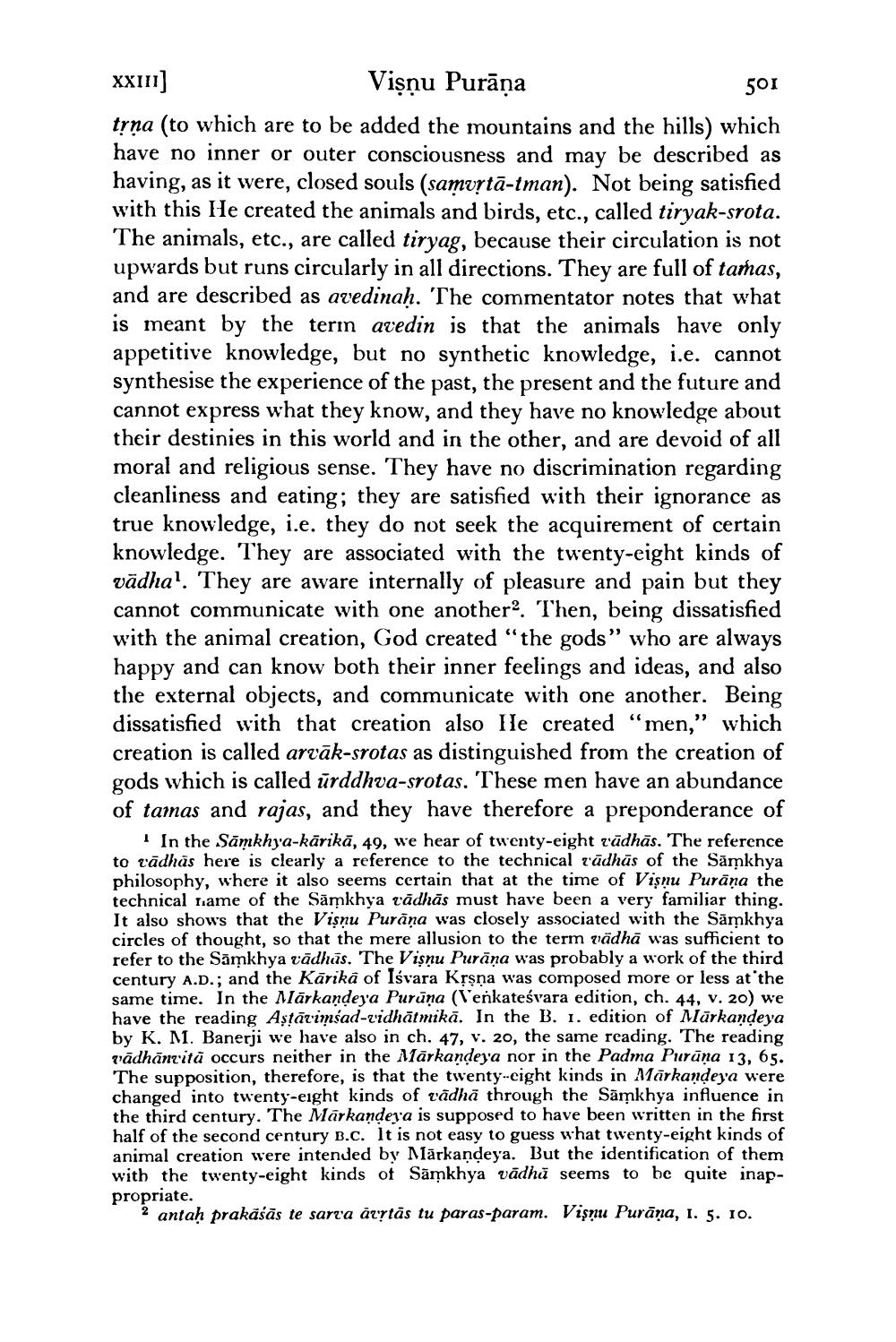________________
XXII] Vişnu Purāņa
501 trna (to which are to be added the mountains and the hills) which have no inner or outer consciousness and may be described as having, as it were, closed souls (samvrtā-tman). Not being satisfied with this He created the animals and birds, etc., called tiryak-srota. The animals, etc., are called tiryag, because their circulation is not upwards but runs circularly in all directions. They are full of tamas, and are described as avedinah. The commentator notes that what is meant by the term avedin is that the animals have only appetitive knowledge, but no synthetic knowledge, i.e. cannot synthesise the experience of the past, the present and the future and cannot express what they know, and they have no knowledge about their destinies in this world and in the other, and are devoid of all moral and religious sense. They have no discrimination regarding cleanliness and eating; they are satisfied with their ignorance as true knowledge, i.e. they do not seek the acquirement of certain knowledge. They are associated with the twenty-eight kinds of vādha'. They are aware internally of pleasure and pain but they cannot communicate with one another. Then, being dissatisfied with the animal creation, God created "the gods” who are always happy and can know both their inner feelings and ideas, and also the external objects, and communicate with one another. Being dissatisfied with that creation also lle created "men," which creation is called arvāk-srotas as distinguished from the creation gods which is called ürddhva-srotas. These men have an abundance of tamas and rajas, and they have therefore a preponderance of
"In the Samkhya-kārikā, 49, we hear of twenty-eight rādhās. The reference to tādhâs here is clearly a reference to the technical tādhās of the Sāmkhya philosophy, where it also seems certain that at the time of Vişnu Purāņa the technical name of the Sāmkhya tādhās must have been a very familiar thing. It also shows that the Visnu Purāņa was closely associated with the Sāmkhya circles of thought, so that the mere allusion to the term vädhā was sufficient to refer to the Sāmkhya rādhās. The Visnu Purāņa was probably a work of the third century A.D.; and the Kārikā of Isvara Krsna was composed more or less at the same time. In the Mlärkandeya Purana (Venkateśvara edition, ch. 44, v. 20) we have the reading Astārimsad-vidhātmikā. In the B. 1. edition of Mārkandeya by K. M. Banerji we have also in ch, 47, v. 20, the same reading. The reading vādhāntitā occurs neither in the Nlārkandeya nor in the Padma Purāņa 13, 65. The supposition, therefore, is that the twenty-eight kinds in Markandeya were changed into twenty-eight kinds of rādhā through the Sāmkhya influence in the third century. The Mārkandeya is supposed to have been written in the first half of the second century B.C. It is not easy to guess what twenty-eight kinds of animal creation were intended by Mlärkandeya. But the identification of them with the twenty-eight kinds of Sāmkhya vādhă seems to be quite inappropriate.
2 antah prakāśās te sarta arytās tu paras-param. Vişnu Purāna, 1. 5. 10.




